Title picture: St Paul’s Cathedral, London
Our interest in England’s cathedrals began with a happenstance visit to the Carlisle Cathedral in 2014. It’s a splendid, dramatic cathedral dating from the Norman era. But unlike St. Paul’s in London and the cathedrals of Canterbury and Salisbury, we’d never heard of it, which left us wondering how many more grand cathedrals England has to offer.
The answer to that question is 42. From the middle ages on, cathedral building has been a favorite English pastime (anyone who’s read Ken Follett’s Pillars of the Earth knows this well). You can hardly turn around without bumping into one. There seem to be more cathedrals here than in more cathedral-expectant countries like Italy and Spain. How else can we say it? How about: the per-capita concentration of cathedrals in England is pretty darn high.
And we’re out to see them all. In the process, we’ve discovered some true gems and we’ve explored quite a bit of England we wouldn’t otherwise have explored. For the moment, we’re focusing only on true cathedrals, those churches that act as the head of a diocese and the home church of a bishop. There are dozens, perhaps hundreds, of splendid non-cathedral churches and abbeys in England, but we’ll focus on the best of them after visiting all of England’s cathedrals.
Most, but not all, of England’s cathedrals were built originally as Roman Catholic churches or cathedrals. They have survived dozens of kings, the reformation and the dissolution of the monasteries, and–in some cases–a millennium of history. This, coupled with their architecture and art, makes for more than enough fascination to go out of our way to experience. So far during our April visit to the UK, we’ve seen 7 more of England’s cathedrals. We plan to see 5 more in the next couple of weeks, which will bring our total to 28.

England’s Cathedrals. Dark green = ones we’ve visited; Light green = ones we plan to visit before we leave in May; Red = ones still to visit.
Here’s a quick overview of the 7 cathedrals we’ve visited most recently:
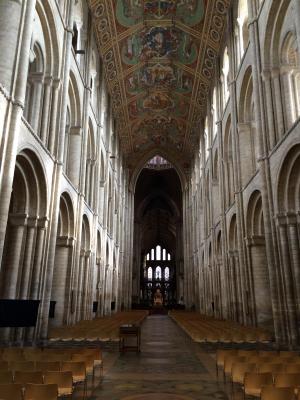
Ely Cathedral
Ely – The town of Ely–rhymes with “steely”–is the home of the “Cathedral Church of the Holy and Undivided Trinity”, a grand 11th century cathedral best known for its octagonal center tower. Its imposing, square west-facing tower is no less impressive, but the most striking feature of the Ely Cathedral for us was the beautifully painted nave ceiling.

Lincoln Cathedral
Lincoln – Lincoln’s “Cathedral Church of the Blessed Virgin Mary of Lincoln” is one of England’s most-loved cathedrals, and it was easy for us to see why. Astride a hill, it offers impressive views over the countryside. You’ll likely spot the cathedral’s towers miles before you reach Lincoln. This cathedral is Chuck’s new favorite cathedral. The town of Lincoln would be worth visiting even if it weren’t for the cathedral, though it’s a bit out of the way. If you visit, plan an overnight stay at the Old Palace Hotel, which is actually the bishop’s palace and offers postcard views of the cathedral.
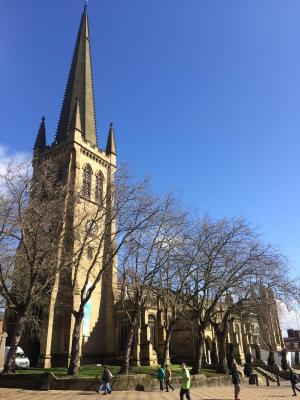
Wakefield Cathedral
Wakefield – The “Cathedral Church of All Saints” in Wakefield, a hop, skip, and jump from Leeds, is one of England’s smaller cathedrals. They were completing a major renovation and cleaning the day we visited, so we didn’t get to explore the apse and chapels and will plan to return one day. Still, the exterior’s pointy spire and the interior’s nave labyrinth were this cathedral’s character standouts.
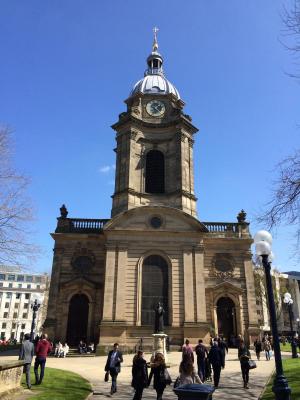
Birmingham Cathedral
Birmingham – For as large a city as Birmingham is, its “Cathedral Church of St Philip” is surprisingly modest. It is best known for striking stained glass windows by Edward Burne-Jones (who played a big role in the Arts and Crafts movement of the 19th century), but we thought the gallery style layout was equally interesting and reminiscent of colonial American churches in Boston and Philadelphia. Speaking of a colonial connection, the Birmingham cathedral is particularly proud to be the burial site of William Small, one of Thomas Jefferson’s teachers and mentors.
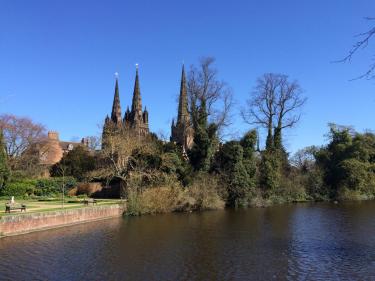
Lichfield Cathedral
Lichfield – The town of Lichfield and its “Cathedral Church of the Blessed Virgin Mary and St Chad” is likely the nicest town and cathedral you’ve never heard of. Boasting the longest nave in England (it certainly seems that way), the cathedral is simply impressive. Lichfield, a northeasterly suburb of Birmingham, is a pleasant town in its own right. The town and the church were the site of a major battle in the English Civil War, and that history is apparent in the statues on the church’s exterior walls.

Coventry Cathedral: ruins on left, modern cathedral on right
Coventry – Coventry’s 14th century cathedral was completely destroyed by German bombs in World War II. With so little left to restore, it was decided to build a new cathedral after the war was over. The design for the “Cathedral Church of St Michael” incorporates the ruins of the old cathedral and through the architecture tells the Christian story of crucifixion (the ruins), resurrection (the new cathedral’s altar), and ascension (the tapestry behind the altar, the largest in England). The ultra modern new cathedral might not appeal to those seeking a medieval experience, but we found the story, the history, and the allegory in architecture very well done.
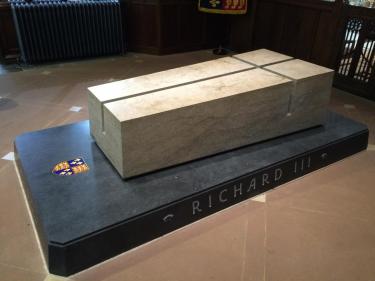
King Richard III’s new tomb, Leicester Cathedral
Leicester – Since the discovery of the remains of King Richard III beneath a nearby Leicester parking lot, the entire city of Leicester (pronounced “Lester”) and Leicester’s “Cathedral Church of St Martin” has been all about King Richard III. If you’re not familiar with this story, read about it here. Since watching the documentary about his discovery a couple of years ago, we’ve followed this story with interest. His remains were reinterred at Leicester Cathedral in March of 2015, giving a much needed shot-in-the-arm to the Leicester Cathedral, whose principle character would otherwise derive almost entirely from its exterior. And congratulations to the city of Leicester for winning the premier league championship!
Before we leave the UK on May 10, we plan to also see the following cathedrals: Worcester, Oxford (yes, that Oxford), St Albans, Rochester, and the “Mac-daddy” of England’s cathedrals, Canterbury. Stay tuned.






